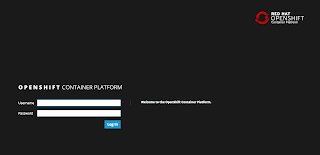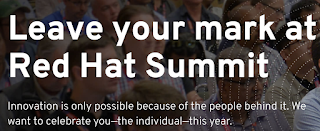 |
| Get OpenShift Container Platform v3.4 today! |
There is no easier way to install your very own Cloud than with
OpenShift Container Platform (OCP).
A few months back I showed you how to go from no Cloud to fully Cloud enabled with a container based application development platform in just over two minutes.
This was based back then on OCP 3.3, but now it's time to update this project to get you onto the newer
version 3.4 with many new features I know you want to get your hands on.
If you have been following my journey through the application development phases of storytelling, you will have seen that I was an early fan of Cloud based solutions like OpenShift. This was a way to take your application development from your local resources and move them onto a remote set of resources, while continuing to work locally as you always have.
 |
| Figure 1. Container images pulled to your box. |
As of today I have updated the
OpenShift Container Platform Install Demo to deliver you version 3.4, without changing any of the installation steps. It is so simple, I believe that anyone can set this up in just over two minutes. Let's take a look, as it it only a three step process:
Install in 3 simple steps...
-
Run 'init.sh', then sit back.
Follow displayed instructions to log in to your brand new OpenShift Container Platform!
 |
Figure 2. The JBoss product templates
are installed from their image streams. |
You need to download and unzip the project, then run the installation script, sit back until you see the output at the end showing you where to log in to your brand new
OpenShift Container Platform.
It will check if you have the required tools installed, if not you will get a pointer to where you need to download these requirements. This means you don't have to worry about finding out what you need, just run the installation and it will tell you where to get anything that is missing.
Also note, that if you have run this installation before, it's setup to always give you a clean running installation by fixing anything that is left running or blocking an installation. Not intervention needed by you.
In figure 1 you see the installation starting, where the container layers are being pulled into your machine and setup.
Validation is shown in figure 2, where the IP address of your OCP login console is presented. I then make sure your OCP has the latest greatest JBoss middleware streams loaded and update the RHEL 7 streams.
Now you are almost ready, just need to show you how to log in.
 |
| Figure 3. Final installation details given. |
Figure 3 shows the address that was dynamically created (in my case it is showing https://192.168.99.100:8443), just paste it into your browser and you can log in with any of the given users. Also note that you might want to completely clean up this demo by running the command shown.
As I have updated the image streams, it will take some time for them to be pulled into your OCP and appear in your lists of available platforms. Log in with admin user and you will see that you need to create a project, just click on the New Project button.
You can fill in the form shown in figure 4 any way you like, but I chose to line it up as the project that will soon host all my
Red Hat Cloud demo projects.
Once you submit that form, you are presented with an overview of the product templates for your projects that I installed above (remember, it might take a few minutes for them all to appear, so take a sip of coffee now as it is your only chance in this process).
 |
| Figure 4. Fill in a new project form as desired. |
You can now start using the catalog containing the JBoss middleware product templates to develop applications on the OCP Cloud.
This concludes the installation of OCP and you are now ready to start containerized application development. I assume you can find more information online if you are interested in getting started with the basics of container development on OCP, so I won't go into that here.
If you are looking for some deeper examples of running JBoss middleware on OCP then check out the examples collection at
Red Hat Demo Central.
Here's wishing you many happy days of containerized application development in the Cloud!












